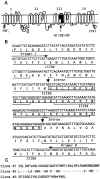Alternative splicing of an insect sodium channel gene generates pharmacologically distinct sodium channels
- PMID: 12097481
- PMCID: PMC3062512
- DOI: 10.1523/JNEUROSCI.22-13-05300.2002
Alternative splicing of an insect sodium channel gene generates pharmacologically distinct sodium channels
Abstract
Alternative splicing is a major mechanism by which potassium and calcium channels increase functional diversity in animals. Extensive alternative splicing of the para sodium channel gene and developmental regulation of alternative splicing have been reported in Drosophila species. Alternative splicing has also been observed for several mammalian voltage-gated sodium channel genes. However, the functional significance of alternative splicing of sodium channels has not been demonstrated. In this study, we identified three mutually exclusive alternative exons encoding part of segments 3 and 4 of domain III in the German cockroach sodium channel gene, para(CSMA). The splice site is conserved in the mouse, fish, and human Na(v)1.6 sodium channel genes, suggesting an ancient origin. One of the alternative exons possesses a stop codon, which would generate a truncated protein with only the first two domains. The splicing variant containing the stop codon is detected only in the PNS, whereas the other two full-size variants were detected in both the PNS and CNS. When expressed in Xenopus oocytes, the two splicing variants produced robust sodium currents, but with different gating properties, whereas the splicing variant with the stop codon did not produce any detectable sodium current. Furthermore, these two functional splicing variants exhibited a striking difference in sensitivity to a pyrethroid insecticide, deltamethrin. Exon swapping partially reversed the channel sensitivity to deltamethrin. Our results therefore provide the first evidence that alternative splicing of a sodium channel gene produces pharmacologically distinct channels.
Figures






Similar articles
-
An alanine in segment 3 of domain III (IIIS3) of the cockroach sodium channel contributes to the low pyrethroid sensitivity of an alternative splice variant.Insect Biochem Mol Biol. 2006 Feb;36(2):161-8. doi: 10.1016/j.ibmb.2005.11.008. Epub 2005 Dec 20. Insect Biochem Mol Biol. 2006. PMID: 16431283 Free PMC article.
-
Distinct functional properties of sodium channel variants are associated with usage of alternative exons in Nilaparvata lugens.Insect Biochem Mol Biol. 2020 Mar;118:103292. doi: 10.1016/j.ibmb.2019.103292. Epub 2019 Dec 4. Insect Biochem Mol Biol. 2020. PMID: 31811885 Free PMC article.
-
An important role of a pyrethroid-sensing residue F1519 in the action of the N-alkylamide insecticide BTG 502 on the cockroach sodium channel.Insect Biochem Mol Biol. 2011 Jul;41(7):446-50. doi: 10.1016/j.ibmb.2011.03.005. Epub 2011 Mar 21. Insect Biochem Mol Biol. 2011. PMID: 21426938 Free PMC article.
-
The Drosophila Sodium Channel 1 (DSC1): The founding member of a new family of voltage-gated cation channels.Pestic Biochem Physiol. 2015 May;120:36-9. doi: 10.1016/j.pestbp.2014.12.005. Epub 2014 Dec 9. Pestic Biochem Physiol. 2015. PMID: 25987218 Review.
-
The molecular interactions of pyrethroid insecticides with insect and mammalian sodium channels.Pest Manag Sci. 2001 Oct;57(10):877-88. doi: 10.1002/ps.392. Pest Manag Sci. 2001. PMID: 11695180 Review.
Cited by
-
Persistent tetrodotoxin-sensitive sodium current resulting from U-to-C RNA editing of an insect sodium channel.Proc Natl Acad Sci U S A. 2004 Aug 10;101(32):11862-7. doi: 10.1073/pnas.0307695101. Epub 2004 Jul 27. Proc Natl Acad Sci U S A. 2004. PMID: 15280550 Free PMC article.
-
Characterization of two kdr mutations at predicted pyrethroid receptor site 2 in the sodium channels of Aedes aegypti and Nilaparvata lugens.Insect Biochem Mol Biol. 2022 Sep;148:103814. doi: 10.1016/j.ibmb.2022.103814. Epub 2022 Aug 3. Insect Biochem Mol Biol. 2022. PMID: 35932971 Free PMC article.
-
An alanine in segment 3 of domain III (IIIS3) of the cockroach sodium channel contributes to the low pyrethroid sensitivity of an alternative splice variant.Insect Biochem Mol Biol. 2006 Feb;36(2):161-8. doi: 10.1016/j.ibmb.2005.11.008. Epub 2005 Dec 20. Insect Biochem Mol Biol. 2006. PMID: 16431283 Free PMC article.
-
A negative charge in transmembrane segment 1 of domain II of the cockroach sodium channel is critical for channel gating and action of pyrethroid insecticides.Toxicol Appl Pharmacol. 2010 Aug 15;247(1):53-9. doi: 10.1016/j.taap.2010.05.016. Epub 2010 Jun 1. Toxicol Appl Pharmacol. 2010. PMID: 20561903 Free PMC article.
-
Spider-venom peptides as bioinsecticides.Toxins (Basel). 2012 Mar;4(3):191-227. doi: 10.3390/toxins4030191. Epub 2012 Mar 22. Toxins (Basel). 2012. PMID: 22741062 Free PMC article. Review.
References
-
- Bell WL. The laboratory cockroach. Chapman and Hall; New York: 1981.
-
- Bourinet E, Soong TW, Sutton K, Slaymaker S, Mathews E, Monteil A, Zamponi GW, Nargeot J, Snutch TP. Splicing of alpha 1A subunit gene generates phenotypic variants of P- and Q. Nat Neurosci. 1999;2:407–415. - PubMed
-
- Burt PE, Goodchild RE. The site of action of pyrethrin I in the nervous system of the cockroach Periplaneta Americana. Ent Exp Appl. 1971;14:179–189.
Publication types
MeSH terms
Substances
Associated data
- Actions
- Actions
Grants and funding
LinkOut - more resources
Full Text Sources
Molecular Biology Databases
